April 14, 2025 | 08:25 GMT +7
April 14, 2025 | 08:25 GMT +7
Hotline: 0913.378.918
April 14, 2025 | 08:25 GMT +7
Hotline: 0913.378.918

Cat Ba langur is one of four primate species endemic to Vietnam. Photo: Huy Cam.
The Cat Ba langur, scientifically known as Trachypithecus poliocephalus policephalus, is one of four primate species endemic to Vietnam. Their natural habitat are concentrated in the forests on the limestone mountains of the Cat Ba archipelago in Hai Phong city.
As an endemic animal, Cat Ba langur has long become the pride of the people on Cat Ba island. However, the population of Cat Ba langur has been reduced to over 70 individuals. The species is in an extremely endangered state, facing a high risk of extinction. The decline in the population of Cat Ba langur has occurred in both the size of the herd as well as the number of individuals within the herd.
An adult Cat Ba langur has an average body length betweeen approximately 47 and 53 centimeters. Its tail can reach between 85 and 90 centimeters in length. The langur's tail also helps it maintain balance while moving on craggy and dangerous limestone mountains.
Young Cat Ba langurs have bright orange-yellow fur at birth. Their fur color starts to progressively turn black after the fourth month, but the fur from the shoulder to the top of the head stays bright yellow.
Due to their long childhood, young langurs are cared for and taught survival skills by adults in the herd. As they mature, the color of the fur on the head of a Cat Ba langur becomes lighter, which is a feature to determine their age.
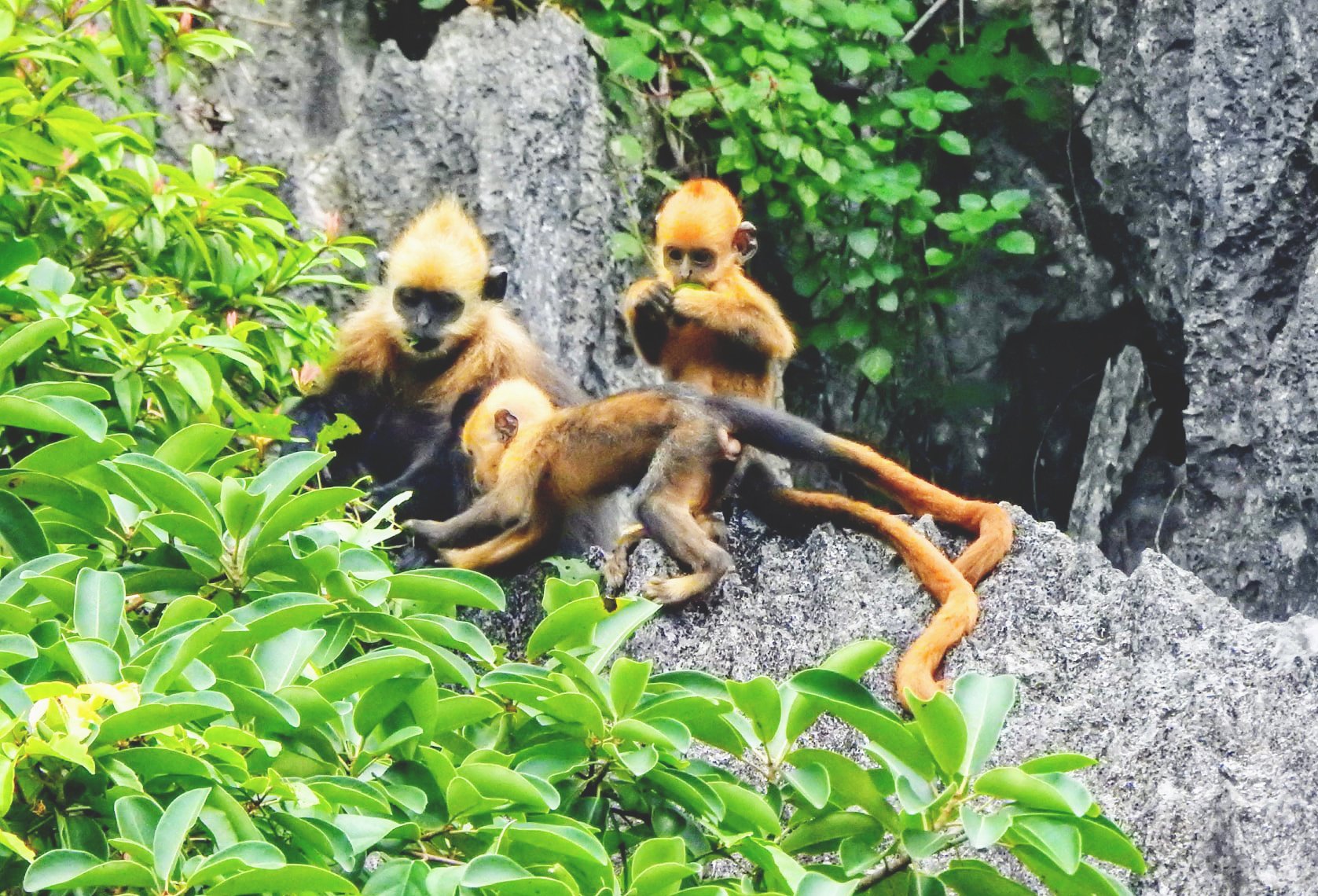
Young Cat Ba langurs have brilliant orange-yellow fur. Photo: Huy Cam.
The average lifespan of a Cat Ba langur falls between 25 and 30 years. They give birth once between the ages of 4 and 6, and the subsequent interval between every birth is roughly two years. Cat Ba langurs have the habit of living in herds as family units. The male leader is responsible for guiding the herd to food sources, alerting the herd to potential dangers and finding a place to sleep. When sensing danger, the leader will stand on a high ridge to signal the entire herd.
Langurs live in forests on craggy limestone mountains on Cat Ba island. They spend they day on high tree floors feeding and resting. At night, they sleep in caves or on the cliff edges of rocky mountains to avoid inclement weather.
The Cat Ba langur's diet primarily consists of leaves, flowers, forest fruits including figs, citrons, etc. Most notably, due to the structure of their stomach and large liver, Cat Ba langurs can eat poisonous leaves and fruits such as heartbreak grass and periwinkle fruits.
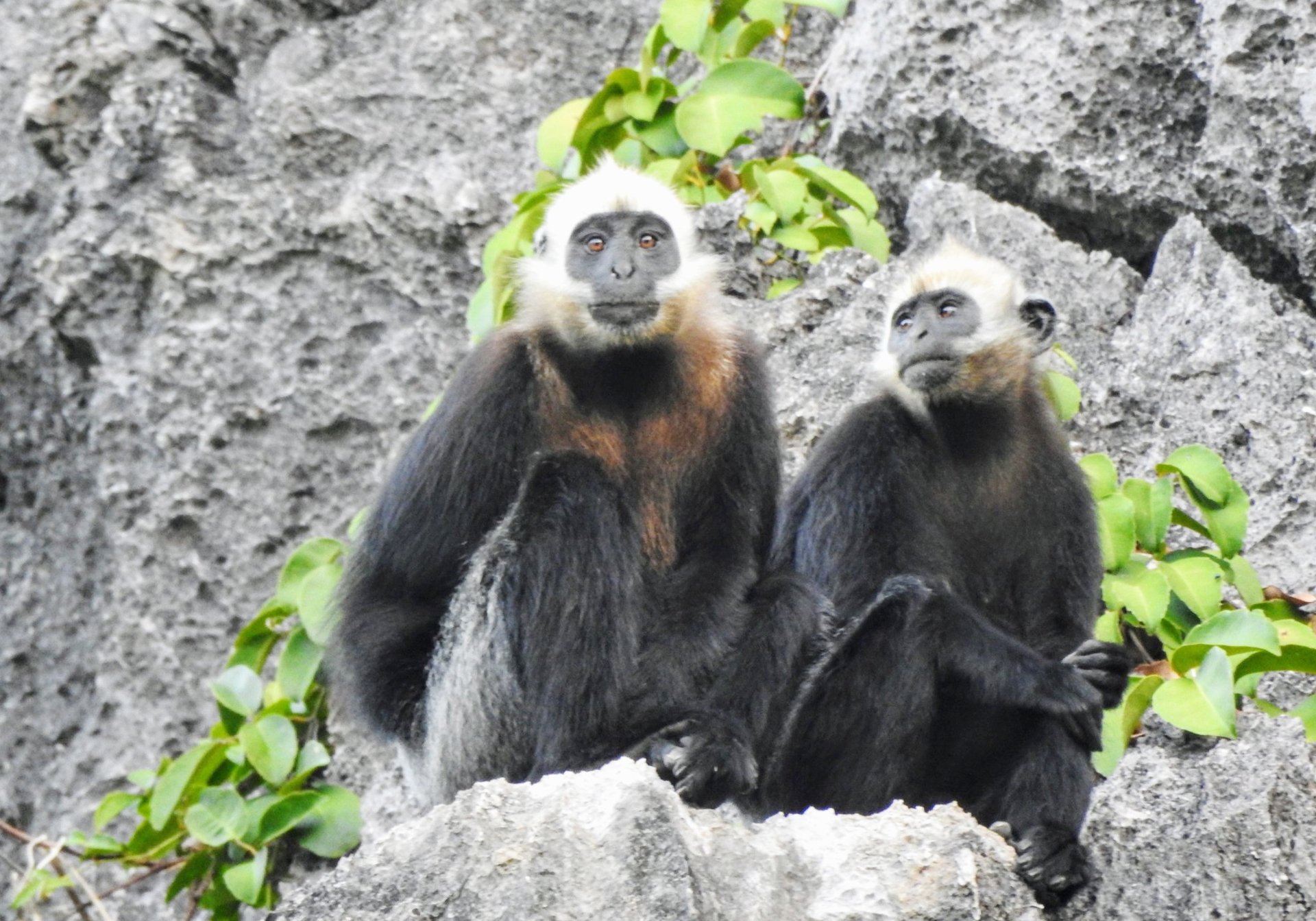
Cat Ba langurs live in herds and live on steep cliffs. Photo: Huy Cam.
The Cat Ba langur population had over a thousand individuals in the past. However, it has declined sharply since the 1960s as settlements and the human population grew on Cat Ba Island in the following decades.
Between 1970 and 1986, the decline rate of Cat Ba Langur picked up significantly and the species was divided into small and disjointed subpopulations.
According to Cat Ba National Park, it is estimated that Cat Ba Langur lost nearly 98% of its population size within 40 years from 1960 to 1990, mainly due to hunting. Additionally, natural selection played a part in the population decline because the increased aging rate led to infertility, inbreeding and overall degradation of the species.
Furthermore, conflicts over herd leadership resulted in serious injuries and even deaths. After every leadership competition, the winning male will kill the young, reducing the next generation of future reproduction and further raising the aging rate.
“Cat Ba langurs thrived on the island over forty years ago. At one point, it was estimated that the entire Cat Ba archipelago had between 2,500 and 3,000 langurs. However, langurs became the most hunted animal on Cat Ba island when their bile was thought to have miraculous medical properties. As a result, the Cat Ba langur herd dropped to less than 40 individuals by the year 2000", shared Mr. Nguyen Van Tang, a former hunter.

The hunting of wild animals is strictly controlled by forest rangers in Cat Ba National Park. Photo: Huy Cam.
According to the Director of Cat Ba National Park, the park and local government have implemented various solutions to protect and develop the langur herd, such as: propagandizing and mobilizing hunters not to illegally hunt wild animals in the forest; increasing patrol, and strictly handling violations.
The authorities' active engagement and the decline in the wild animals population have forced Cat Ba's hunters to quit and transition to fishing and tourism services. Several hunters have even been encouraged to participate in the forest and langur protection program initiated by Cat Ba National Park and NGOs.
However, Cat Ba langurs have not escaped the danger of extinction because male langurs often kill their young after taking control of the herd. On the other hand, young langurs are born prematurely due to inbreeding, resulting in additional difficulties for the conservation of Cat Ba langurs.
Starting from the year 2000, the illegal hunting of Cat Ba langur has decreased sharply, and the langur population has gradually recovered. Between 2022 and the first half of 2023, over 10 new langurs were born, bringing the total number of Cat Ba langurs to over 70.
“In order to prevent the killing of baby langurs and prevent inbreeding, Cat Ba National Park has collaborated with relevant Hai Phong city officials, scientists, NGOs, etc., to relocate herdless males to other zones. On the other hand, the park has promoted the image of Cat Ba langur to the domestic and international community, calling for more organizations to cooperate in the conservation and development of langurs", remarked Mr. Nguyen Van Thiu, Director of Cat Ba National Park.
Translated by Nguyen Hai Long
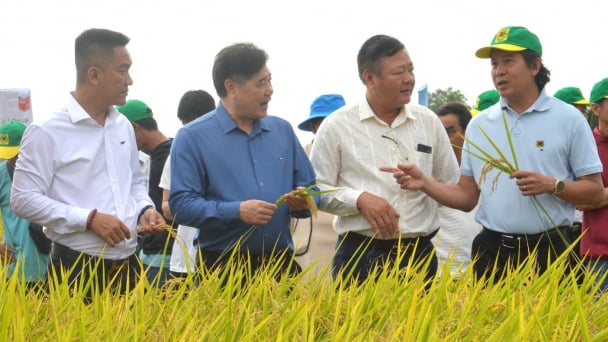
(VAN) The results from pilot fields are catalyzing the expansion of the One million hectares of high-quality, low-emission rice project in Kien Giang.
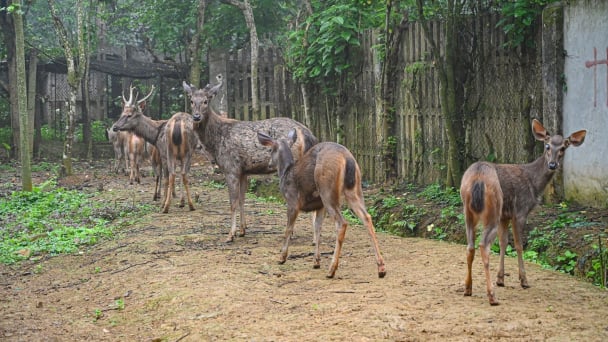
(VAN) On the morning of April 11, Cuc Phuong National Park received 18 individuals of endangered and rare wild animals from Da Nang city.

(VAN) FAO supports Vietnam in enhancing survey sampling techniques for the 2025 nationwide agricultural and rural census.
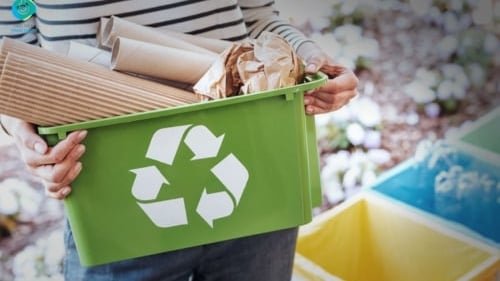
(VAN) By participating in the green transition, manufacturers become an indispensable part of the circular economy, contributing to resource optimization and environmental protection.

(VAN) The One Million Hectares of High-Quality and Low-Emission Rice Program can generate nearly 14 million tons of straw annually, posing an urgent requirement to diversify straw-based products.

(VAN) This figure was recently announced at a conference held in Yen Bai, focusing on climate-resilient infrastructure development for ethnic minority regions.

(VAN) The evacuation center is a practical work in efforts to respond to natural disasters and adapt to climate change in vulnerable areas.